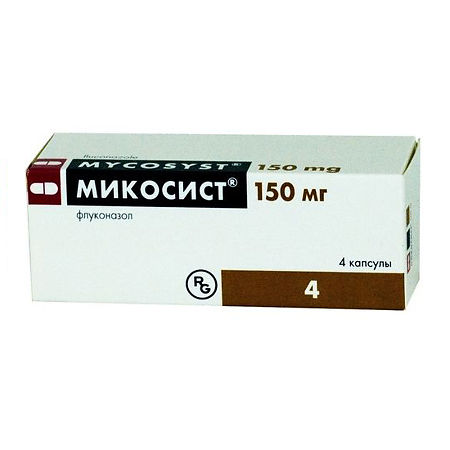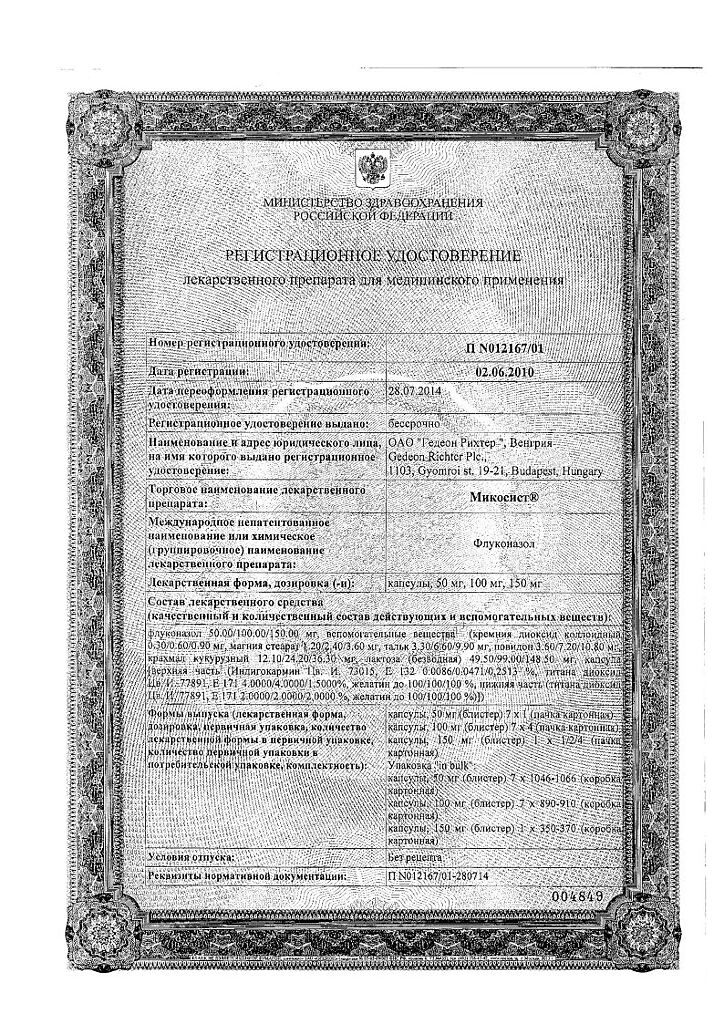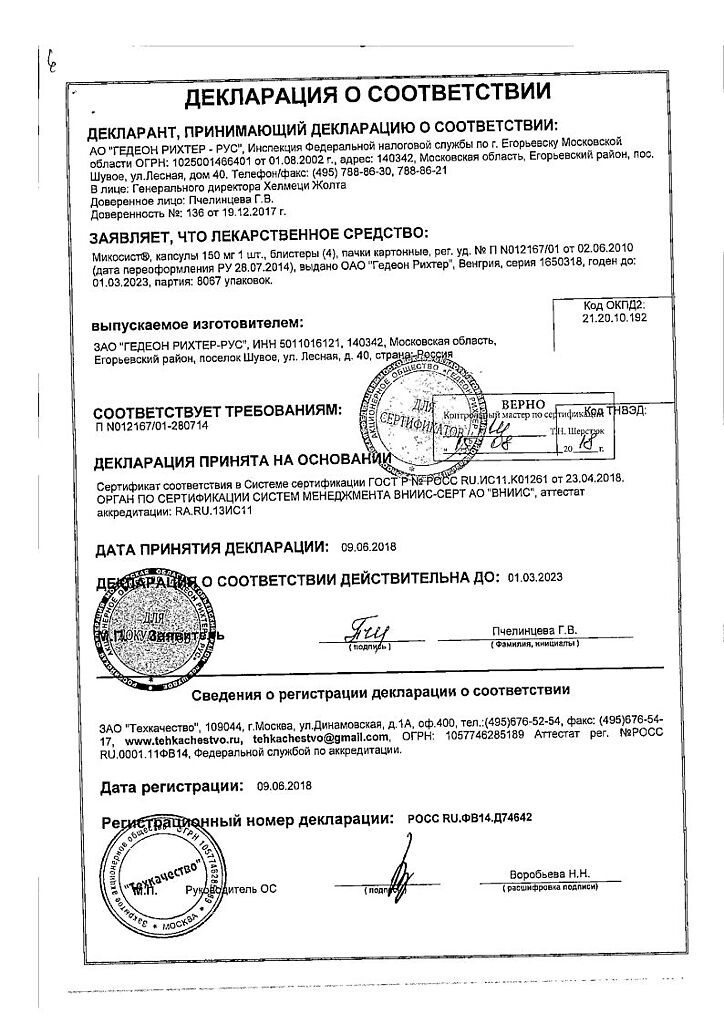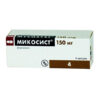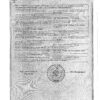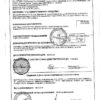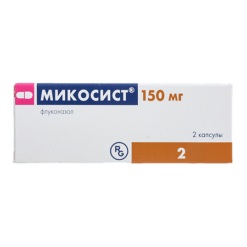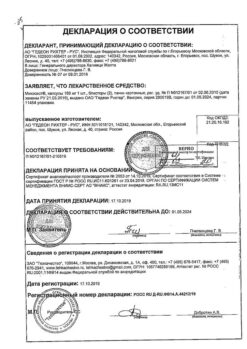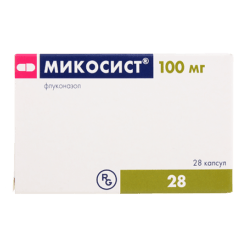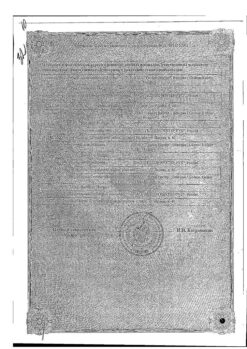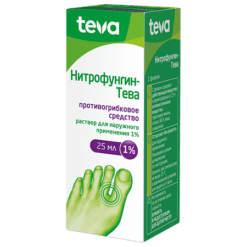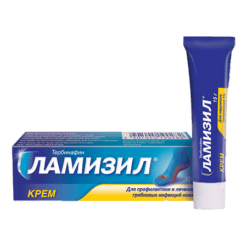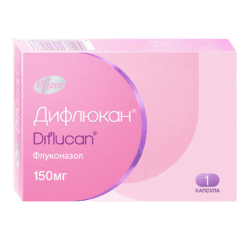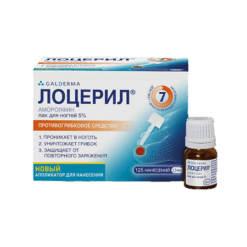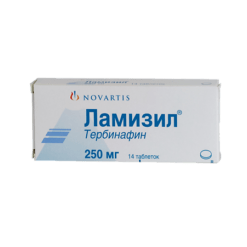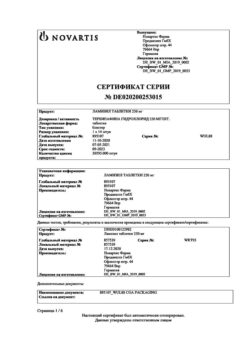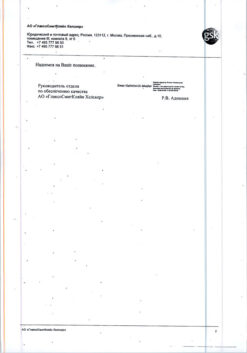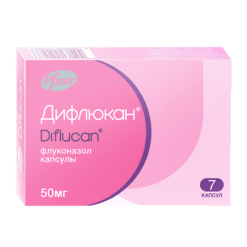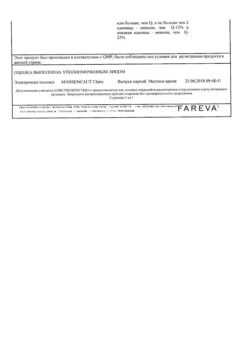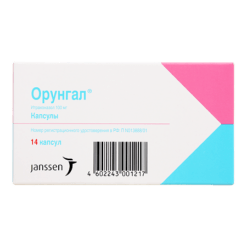No products in the cart.
Mycosyst, 150 mg capsules 4 pcs
€16.99 €14.73
Out of stock
(E-mail when Stock is available)
Description
Mycosyst is an antifungal drug. Fluconazole, a representative of the class of triazole antifungal agents, is a selective inhibitor of sterol synthesis in the fungal cell.
Fluconazole, being highly selective for cytochrome P450 of fungi, practically does not inhibit the cytochrome P450 system in the human body (compared to itraconazole, clotrimazole, econazole and ketoconazole it inhibits cytochrome P450 dependent oxidation processes in human liver microsomes to a lesser extent).
It has no androgenic activity.
It is active against mycosis pathogens caused by Candida spp., Cryptococcus neoformans, Microsporum spp., Trichophyton spp. Fluconazole activity has also been shown in models of endemic mycoses, including infections caused by Blastomyces dermatitidis, Coccidioides immitis and Histoplasma capsulatum.
Pharmacokinetics
Absorption
Fluconazole is well absorbed after oral administration, its bioavailability is 90%. Cmax after oral administration on an empty stomach of 150 mg is reached after 0.5-1.5 hours and makes 90% of concentrations in plasma in a dose of 2.5-3.5 mg/kg. Concomitant intake of food has no effect on absorption of the drug taken orally.
Distribution
Fluconazole penetrates well into all tissues and body fluids after oral and intravenous administration. High concentrations are achieved in the stratum corneum, dermis and sweat fluids, which exceed serum concentrations. After oral administration of 150 mg on the 7th day the concentration in the stratum corneum of the skin is 23.4 µg/g, and 1 week after the second dose – 7.1 µg/kg, the concentration in the nails after 4 months of use at a dose of 150 mg once/week is 4.05 µg/g in healthy and 1.8 µg/g in the affected nails.
The drug concentrations in saliva, sputum, breast milk, joint and peritoneal fluid are similar to its plasma concentrations. In patients with fungal meningitis, fluconazole content in cerebrospinal fluid reaches 80% of the corresponding concentration in plasma. Constant values in vaginal secretion are reached 8 hours after oral administration and remain at this value for at least 24 hours.
Plasma concentrations are directly proportional to the dose. 90% equilibrium concentrations are reached by day 4-5 with daily oral administration or once daily infusion.
The first day’s dose of twice the usual daily dose achieves 90% of the equilibrium concentration by the second day. The apparent Vd approaches the total volume of water in the body. With plasma proteins 11-12% of fluconazole is bound.
Metabolism and excretion
It is an inhibitor of CYP2C9 isoenzyme in the liver. No fluconazole metabolites were detected in the peripheral blood.
T1/2 – 30 h. Fluconazole pharmacokinetics depends significantly on the functional state of the kidneys, and there is an inverse relationship between T1/2 and creatinine clearance. Fluconazole is excreted mainly by the kidneys; approximately 80% of the administered dose is excreted unchanged. Fluconazole clearance is directly proportional to creatinine clearance.
In 3 hours after hemodialysis plasma concentration of fluconazole decreases by 50%.
Indications
Indications
fungus of the skin, nails and internal organs
mucosal candidiasis
antifungal cover during antibiotic treatment.
Pharmacological effect
Pharmacological effect
Mikosist is an antifungal drug. Fluconazole, a member of the triazole antifungal class, is a selective inhibitor of sterol synthesis in fungal cells.
Fluconazole, being highly selective for cytochrome P450 of fungi, practically does not inhibit the cytochrome P450 system in the human body (in comparison with itraconazole, clotrimazole, econazole and ketoconazole, it suppresses cytochrome P450-dependent oxidative processes in human liver microsomes to a lesser extent).
Does not have androgenic activity.
Active against pathogens of mycoses caused by Candida spp., Cryptococcus neoformans, Microsporum spp., Trichophyton spp. Fluconazole has also been shown to be active in models of endemic mycoses, including infections caused by Blastomyces dermatitidis, Coccidioides immitis and Histoplasma capsulatum.
Pharmacokinetics
Suction
After oral administration, fluconazole is well absorbed, its bioavailability is 90%. Cmax after oral administration on an empty stomach of 150 mg is achieved after 0.5-1.5 hours and is 90% of the plasma concentration when administered intravenously at a dose of 2.5-3.5 mg/kg. Concomitant food intake does not affect the absorption of the drug taken orally.
Distribution
After oral and intravenous administration, fluconazole penetrates well into all tissues and fluids of the body. In the stratum corneum of the epidermis, dermis and sweat fluid, high concentrations are reached that exceed serum concentrations. After oral administration of 150 mg on the 7th day, the concentration in the stratum corneum of the skin is 23.4 mcg/g, and 1 week after taking the second dose – 7.1 mcg/kg, the concentration in the nails after 4 months of use at a dose of 150 mg once a week is 4.05 mcg/g in healthy and 1.8 mcg/g in affected nails.
Concentrations of the drug in saliva, sputum, breast milk, joint and peritoneal fluid are similar to its concentration in blood plasma. In patients with fungal meningitis, the content of fluconazole in the cerebrospinal fluid reaches 80% of the corresponding concentration in plasma. Constant values in vaginal secretions are achieved 8 hours after oral administration and are maintained at this value for at least 24 hours.
Plasma concentrations are directly proportional to dose. 90% equilibrium concentration is achieved by 4-5 days with daily oral or intravenous administration 1 time / day.
Use on the first day of a dose 2 times higher than the usual daily dose allows you to achieve 90% of the equilibrium concentration by the second day. The apparent Vd approaches the total volume of water in the body. 11-12% of fluconazole is bound to plasma proteins.
Metabolism and excretion
It is an inhibitor of the CYP2C9 isoenzyme in the liver. No fluconazole metabolites were detected in peripheral blood.
T1/2 – 30 hours. The pharmacokinetics of fluconazole significantly depends on the functional state of the kidneys, and there is an inverse relationship between T1/2 and creatinine clearance. Fluconazole is excreted from the body mainly by the kidneys; in this case, approximately 80% of the administered dose is excreted unchanged. Fluconazole clearance is directly proportional to creatinine clearance.
After hemodialysis for 3 hours, the concentration of fluconazole in plasma decreases by 50%.
Special instructions
Special instructions
Treatment with fluconazole must be continued until clinical and hematological remission occurs. Premature cessation of treatment leads to relapses.
Since fluconazole is eliminated primarily by the kidneys, caution should be exercised in patients with renal impairment. During long-term treatment with fluconazole, dosing should be based on creatinine clearance. In rare cases, the use of fluconazole was accompanied by toxic effects on the liver, incl. and with a fatal outcome, mainly in patients with serious concomitant diseases. It is necessary to monitor liver function. If signs of liver damage appear that may be associated with taking fluconazole, the drug should be discontinued.
While taking the drug, patients experienced rare cases of the development of exfoliative skin reactions, such as Stevens-Johnson syndrome and toxic epidermal necrolysis. Patients with AIDS and cancer are more likely to develop severe skin reactions when using many drugs. If a patient develops a rash during treatment for a superficial fungal infection that can be associated with the use of fluconazole, the drug should be discontinued. If rash occurs in patients with invasive/systemic fungal infections, they should be monitored closely and fluconazole should be discontinued if bullous lesions or erythema multiforme develop. Caution must be exercised when taking fluconazole concomitantly with rifabutin or other drugs metabolized by the cytochrome P450 system.
It is necessary to monitor PT in patients simultaneously receiving fluconazole and indirect coumarin anticoagulants.
Effect on the ability to drive a car and operate other mechanical equipment. Patients should be careful when driving vehicles or operating machinery, as dizziness may occur during treatment with fluconazole.
Active ingredient
Active ingredient
Fluconazole
Composition
Composition
1 capsule contains:
Active ingredient:
fluconazole 150 mg;
Excipients:
colloidal silicon dioxide;
magnesium stearate;
talc;
povidone;
corn starch;
lactose anhydrous.
Pregnancy
Pregnancy
The use of fluconazole during pregnancy is only possible if the potential benefit to the mother outweighs the risk to the fetus.
Fluconazole is determined in breast milk in the same concentration as in plasma, therefore its administration during lactation is contraindicated.
Contraindications
Contraindications
simultaneous use of terfenadine (against the background of constant use of fluconazole at a dose of 400 mg/day or higher) and cisapride, because both drugs prolong the QT interval and increase the risk of developing severe cardiac arrhythmias;
simultaneous use of astemizole;
lactation period (breastfeeding);
lactose intolerance, lactase deficiency, glucose-galactose malabsorption;
hypersensitivity to the components of the drug or azole compounds similar in structure.
With caution: liver and/or renal failure; the appearance of a rash during the use of fluconazole in patients with superficial fungal infection and invasive/systemic fungal infections; simultaneous use of fluconazole with rifabutin or other drugs metabolized by isoenzymes of the cytochrome P450 system; simultaneous use of terfenadine and fluconazole at a dose of less than 400 mg/day; potentially proarrhythmogenic conditions in patients with multiple risk factors (organic heart disease, electrolyte imbalance, concomitant use of drugs that cause arrhythmias); intolerance to acetylsalicylic acid; pregnancy.
Side Effects
Side Effects
From the digestive system: nausea, vomiting, diarrhea, flatulence, abdominal pain, change in taste, impaired liver function (hyperbilirubinemia, increased activity of liver transaminases, alkaline phosphatase, jaundice, hepatitis, hepatocellular necrosis, including death).
From the nervous system: headache, dizziness, convulsions.
From the hematopoietic organs: leukopenia, thrombocytopenia, neutropenia, agranulocytosis.
Allergic reactions: skin rash, exudative erythema multiforme (including Stevens-Johnson syndrome), toxic epidermal necrolysis (Lyell’s syndrome), anaphylactoid reactions (including angioedema, facial swelling, urticaria, skin itching), bronchial asthma (more often with intolerance to acetylsalicylic acid).
From the cardiovascular system: increased duration of the QT interval on the ECG, ventricular fibrillation/flutter.
Other: renal dysfunction, alopecia, hypercholesterolemia, hypertriglyceridemia, hypokalemia.
Interaction
Interaction
Anticoagulants. In patients taking fluconazole and indirect coumarin anticoagulants, careful monitoring of PT is necessary, as it may increase.
Sulfonylureas. Fluconazole, when taken simultaneously, can prolong T1/2 of sulfonylurea derivatives, therefore, when using them together, the possibility of developing hypoglycemia should be taken into account.
Phenytoin. The simultaneous use of fluconazole and phenytoin may be accompanied by an increase in the concentration of phenytoin to a clinically significant extent, which requires a reduction in its dose.
Rifampicin. When taking rifampicin and fluconazole simultaneously, the Cmax and T1/2 of the latter decreases, therefore, if combined use is necessary, the dose of fluconazole should be increased.
Rifabutin. The combined use of fluconazole and rifabutin is accompanied by an increase in the serum concentration of the latter, and the development of uveitis is possible.
Cyclosporine. When using fluconazole and cyclosporine together, it is recommended to monitor the concentration of the latter in the blood, as it may increase.
Terfenadine. Considering the occurrence of serious, life-threatening arrhythmias in patients taking antifungal agents – azole derivatives in combination with terfenadine, their combined use is contraindicated.
Cisapride. When taking fluconazole and cisapride simultaneously, cases of adverse reactions from the heart, including paroxysms of ventricular tachycardia, have been described. Simultaneous use is contraindicated.
Zidovudine. When combined with fluconazole, it is possible to increase the concentration of zidovudine in the blood plasma. Patients taking this combination should be monitored for side effects of zidovudine.
Theophylline. Taking fluconazole leads to a decrease in the average rate of clearance of theophylline from blood plasma, therefore increasing the risk of developing the toxic effect of theophylline and its overdose.
Midazolam. The simultaneous use of fluconazole and midazolam leads to a significant increase in the concentration of the latter in the blood plasma and the risk of developing psychomotor reactions.
Hydrochlorothiazide. When taking fluconazole and hydrochlorothiazide simultaneously, the concentration of fluconazole in the blood plasma increases by 40%.
Tacrolimus. When fluconazole and tacrolimus are taken simultaneously, the concentration of the latter in the blood serum increases, which leads to an increased risk of nephrotoxicity.
Caution must be exercised when using fluconazole in patients simultaneously receiving other drugs metabolized by the cytochrome P450 system.
Overdose
Overdose
Symptoms: nausea, vomiting, diarrhea; in severe cases, convulsions, hallucinations, and paranoid behavior may occur.
Treatment: symptomatic (gastric lavage, forced diuresis, hemodialysis). After a 3-hour hemodialysis session, the concentration of fluconazole in the blood plasma decreases by approximately 50%.
Storage conditions
Storage conditions
At a temperature not exceeding 30 °C
Shelf life
Shelf life
5 years
Manufacturer
Manufacturer
Gedeon Richter-RUS, Russia
Additional information
| Shelf life | 5 years |
|---|---|
| Conditions of storage | At a temperature not exceeding 30 °C |
| Manufacturer | Gedeon Richter, Hungary |
| Medication form | capsules |
| Brand | Gedeon Richter |
Other forms…
Related products
Buy Mycosyst, 150 mg capsules 4 pcs with delivery to USA, UK, Europe and over 120 other countries.

